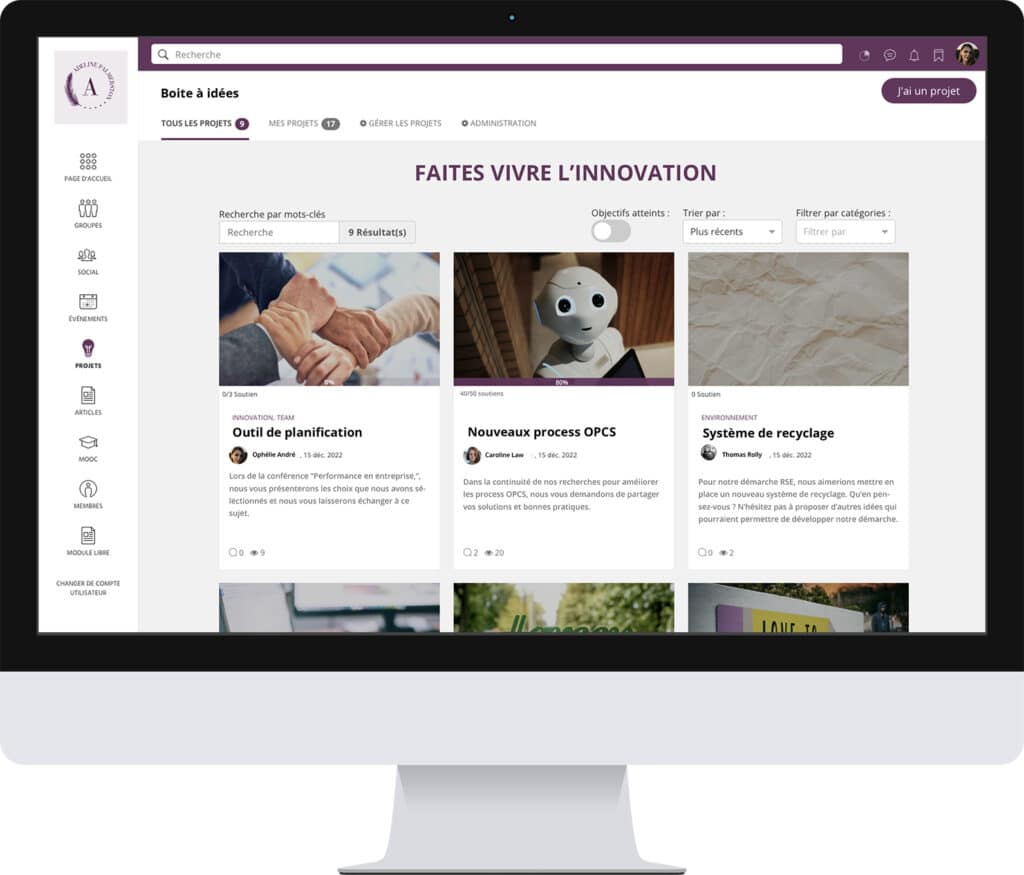Are you wondering how to engage your communities to strengthen your reputation, boost performance and drive innovation? In this article, we'll look at the benefits of an engaged community, the methods you need to put in place to achieve it, and an analysis of key success indicators.
Ultimately, understanding the importance of engaging your communities is crucial to thriving in an ever-changing environment .

What are the benefits of engaging your communities?
You are an organization facing a community. This can be a community of employees, customers, partners, talents, etc. Whatever your objective (business, HR or reputation), it's in your interest to keep this community engaged.
Benefits for community members
Increased influence
Structuring a community is an opportunity to give its members a real voice. For example, you can involve your community members in decision-making processes. This gives them the opportunity to help shape the direction of the organization. As a result, they feel more invested in the organization's evolution.
Better communication
Naturally, if you animate and engage your community, you'll improve communication with its members. This applies equally to top-down communication (from the organization to its members), bottom-up communication (from the members to the organization) and transversal communication (between the members themselves).
A better understanding of needs
By listening carefully to members' feedback, and understanding their concerns, you'll be better equipped to satisfy them. Indeed, animating your community also means maintaining a certain closeness with it, through open and above all constant dialogue. This will give you a deeper, more nuanced understanding of what really matters to your members.
A stronger sense of belonging
Engaging your community goes beyond simple professional interaction. It can create a deep sense of belonging to your company. In particular, when members feel valued and listened to, they develop a stronger bond with the organization. This stronger bond can encourage them to become true ambassadors for your organization.
Benefits for organizations
A better reputation
By creating a relationship of exchange and trust with all the stakeholders around it, an organization has everything to gain. First and foremost, it will benefit from the expertise of all concerned, but also from a better overall image.
Improved competitiveness
When you solicit creative ideas and constructive feedback from your community members, you nurture fertile ground for innovation. Indeed, your members' feedback and perspectives are a valuable source of inspiration for developing new approaches .
Risk reduction
By maintaining an open dialogue with truly engaged communities, you can quickly identify and resolve potential problems. And before they become major crises. So you can anticipate emerging concerns and take steps to mitigate them.
Long-term value creation
By investing in positive interactions, you strengthen a quality bond with the members of your communities. Depending on the nature of these communities, you can improve the loyalty of your existing customers, attract new talent, build employee loyalty and maintain ongoing support from your partners. This long-term value creation is not limited to immediate gains; it contributes to the longevity of your business by building strong relationships that continue to bear fruit over time.

What are the best practices for engaging your communities?
To engage your communities effectively, your approach needs to be strategic and your practices well-defined.
Be an active...and reactive listener!
Be attentive to the comments, concerns and suggestions of your stakeholders. An effective approach is to set up listening mechanisms such as surveys, open discussion groups and other information-gathering methods .
💡 For example, you can organize regular surveys of your customer community to gauge their satisfaction and gather ideas for improvement. This active listening keeps you in tune with stakeholders' needs and expectations, reinforcing their sense of involvement and value.
Be as transparent as possible
It's about communicating openly about company decisions, projects and policies. Transparency shows that you respect the opinions of your stakeholders, and this builds trust.
💡 For example, you can share with members of your community the results of some of your actions in the form of key figures. This transparency then ensures that stakeholders are fairly informed and understand the motivations behind the organization's actions. The result: fewer misunderstandings and greater trust.
Customize your own methods
Personalized interactions are essential to meet the specific needs of YOUR members. In particular, it's important to open communication channels on subjects that really interest them .
💡 For example, you can organize focus groups on specific topics to address particular concerns. This approach allows you to target specific irritants and propose tailored solutions, demonstrating the company's commitment to satisfying its stakeholders on an individualized basis.
Keep the dialogue going to engage your communities
Ongoing dialogue is a crucial practice in maintaining strong relationships with stakeholders. It's not just about communicating when necessary, but maintaining an active dialogue throughout the year . Regular meetings, online forums and newsletters are valuable tools for maintaining this constant exchange.
💡 You could, for example, organize quarterly meetings with your communities to discuss progress and upcoming challenges. This approach keeps you connected and ensures ongoing mutual understanding.

Grow and advance to engage your communities
This is an often underestimated element of engagement. It's abouthelping your community members to always have the right level of knowledge to "stay on track". In other words, providing them with relevant information so that they can make informed decisions in their work. This can be achieved through learning paths, training sessions or informative documents.
💡 For example, you can offer skills enhancement courses to familiarize your members with strategic issues. This acculturation strengthens stakeholders' ability to contribute meaningfully and understand the impact of their actions on your company.
Encourage collaboration
It's an essential dimension of stakeholder engagement for solving problems and creating new opportunities. It strengthens the links between the company and its stakeholders.
💡 For example, you can organize collaborative workshops where stakeholders work together to solve specific challenges. This approach fosters a spirit of partnership and builds mutual trust.
Create reward programs
Rewards and incentives are powerful ways of recognizing and valuing your members' commitment. Reward programs, such as financial incentives, discounts or donations to charities on their behalf, motivate stakeholders to make a significant contribution to the company.
💡 For example, you can offer special benefits to your most loyal customers or publicly recognize the outstanding contributions of your employees. These rewards strengthen the bond between the company and its stakeholders, creating a virtuous circle of ongoing commitment.

How can you engage your communities with a dedicated platform?
A dedicated platform can be particularly effective in facilitating community animation and creating long-term commitment, thanks to :
- Centralized interaction: providing a single space where community members can meet. This simplifies interaction management and enables more effective monitoring of conversations.
- Facilitating exchanges: it encourages open and transparent exchanges between community members. This encourages communication and information sharing.
- Encouraging innovation : members can put forward ideas and suggestions, encouraging innovation. You can gather valuable feedback to adjust your animation strategy.
- Skills development: a dedicated platform makes training resources, webinars and learning paths available to community members, helping them to develop their skills.
Tips for building a community on a platform
- Create a user-friendly platform: to start with, make sure the platform is intuitive and easy to use. Community members need to be able to navigate effortlessly and participate actively.
- Promote active participation: encourage members to contribute by asking questions, holding open discussions and soliciting their opinions on key topics.
- Reward participation: set up reward or recognition systems for the most active or contributing members. This can encourage continued participation.
- Provide useful resources: offer relevant resources, such as articles, guides, videos or tutorials, to help members develop their skills and stay informed.
- Establish clear rules of conduct: define rules and guidelines to maintain a respectful and constructive environment on the platform.
- Facilitate moderation: have a dedicated moderation team to manage discussions and resolve conflicts when necessary.
- Gather feedback: regularly ask community members for their comments on the platform and possible improvements.
- Measuring impact: finally, use key performance indicators (KPIs) to assess the effectiveness of the platform, such as the number of active members, participation rates, and ideas implemented thanks to community feedback.

How do you measure the impact of an engaged community?
Measuring the impact of your communities' engagement on your dedicated platform is essential to understanding the value your community brings to your business or project.
Define clear objectives and identify KPIs
To begin with, it's essential to define clear objectives. These SMART objectives can include increasing the number of active users, increasing engagement, improving the quality of discussions, etc.
To learn how to define SMART indicators, download our Guide Book
Once you've defined your objectives, identify the relevant KPIs for measuring community engagement. These KPIs are part of a process of progress, as discussed in this article. They will vary according to your platform and your objectives, but they can include metrics such as engagement rate, number of new members, response rate to publications, time spent on the platform, number of messages posted, etc.
Data collection and analysis
This can be done by using, among other things, data analysis tools, user tracking tools, community member surveys, and by actively monitoring activity on the platform.
Once you've collected data, analyze it for meaningful insights. Identify trends, patterns, peaks in activity, particularly active member segments, etc.
Measuring member satisfaction
Community engagement isn't just about numbers. Measure member satisfaction too, using satisfaction surveys, direct feedback, content ratings and so on. This will give you an insight into the quality of the community experience.
Compare with targets and take corrective action
Compare the data collected with the objectives you defined in step 1. This will enable you to determine whether you are achieving your objectives, or whether adjustments are necessary.
If the data indicates that you're not meeting your community engagement targets, take corrective action. This could involve changes to content strategy, improvements to platform usability, more effective communication with members, and so on.
Tracking evolution over time
Community involvement is not static. It evolves over time in response to a variety of factors. In fact, make sure you continue to measure and track the impact of community engagement at regular intervals. You need to make sure you stay on track to achieve your goals.
Communicating results
Share the results with your organization's stakeholders. This will further engage members on your platform. They'll feel involved and see their contributions have a real impact in achieving objectives.
Adjust strategy
Finally, based on results and feedback, adjust your community engagement strategy to maximize its impact and meet your objectives.
